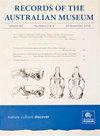Metal-Age maritime culture at Jareng Bori rockshelter, Pantar Island, eastern Indonesia
IF 0.8
4区 生物学
Q4 ZOOLOGY
引用次数: 5
Abstract
The archaeological record of Wallacea remains exceptionally fragmentary. This is especially the case for late Holocene human occupation of the region when lifestyle and culture in marginal island environments is relatively unknown. Here we report on the archaeology of Jareng Bori rockshelter, a Metal-Age site spanning c. 1800 cal. BP up to the late historic period and situated on the eastern coast of Pantar Island in the Lesser Sunda Islands of eastern Indonesia. We use osteoarchaeological (human and vertebrate remains), invertebrate zooarchaeological (crustacean and molluscan remains), technological (lithics, shell, and pottery) and chemical sourcing (obsidian and metal) datasets to discuss networking, migration, and human subsistence strategies during this recent period of history. While some communities were no doubt living in open village settlements where they were producing pottery, the data indicate that aspects of maritime life-ways continued much as in earlier Pleistocene settlements, with people using rockshelters like Jareng Bori to pursue a range of subsistence activities focused on the shoreline. Shellfishing of rocky and reef intertidal species and fishing for mostly small herbivorous and omnivorous fishes was practised, while domestic animals only appear in the late historic period. Wider regional cultural interactions and networking are epitomized by obsidian exchange, dental modification practices, and pottery decorations, while lithic analyses indicates continuity of stone tool technology up until recent times.印度尼西亚东部潘塔岛Jareng Bori岩石避难所的金属时代海洋文化
Wallacea的考古记录仍然非常零碎。全新世晚期人类在该地区的生活方式和文化相对未知时尤其如此。在这里,我们报道了Jareng Bori岩石避难所的考古,这是一个金属时代的遗址,横跨约1800 cal. BP,直到历史晚期,位于印度尼西亚东部小巽他群岛的Pantar岛东海岸。我们使用骨考古学(人类和脊椎动物遗骸)、无脊椎动物考古学(甲壳类动物和软体动物遗骸)、技术(石器、贝壳和陶器)和化学来源(黑曜石和金属)数据集来讨论最近一段历史时期的网络、迁徙和人类生存策略。虽然一些社区无疑生活在开放的村庄定居点,他们生产陶器,但数据表明,海洋生活方式的各个方面与更新世早期的定居点一样,人们使用Jareng Bori这样的岩石庇护所,从事一系列以海岸线为中心的生存活动。岩石和珊瑚礁潮间带物种的贝类捕捞和大多数小型草食性和杂食性鱼类的捕捞,而家畜只出现在历史后期。更广泛的区域文化互动和网络集中体现在黑曜石交换、牙齿修饰实践和陶器装饰上,而石器分析表明直到最近石器工具技术的连续性。
本文章由计算机程序翻译,如有差异,请以英文原文为准。
求助全文
约1分钟内获得全文
求助全文
来源期刊
CiteScore
0.90
自引率
0.00%
发文量
9
审稿时长
>12 weeks
期刊介绍:
Records of the Australian Museum, volume 62 was published in 2010, volume 63 in 2011. Monographic works of particular significance are published irregularly as Records of the Australian Museum, Supplements (ISSN 0812-7387).

 求助内容:
求助内容: 应助结果提醒方式:
应助结果提醒方式:


